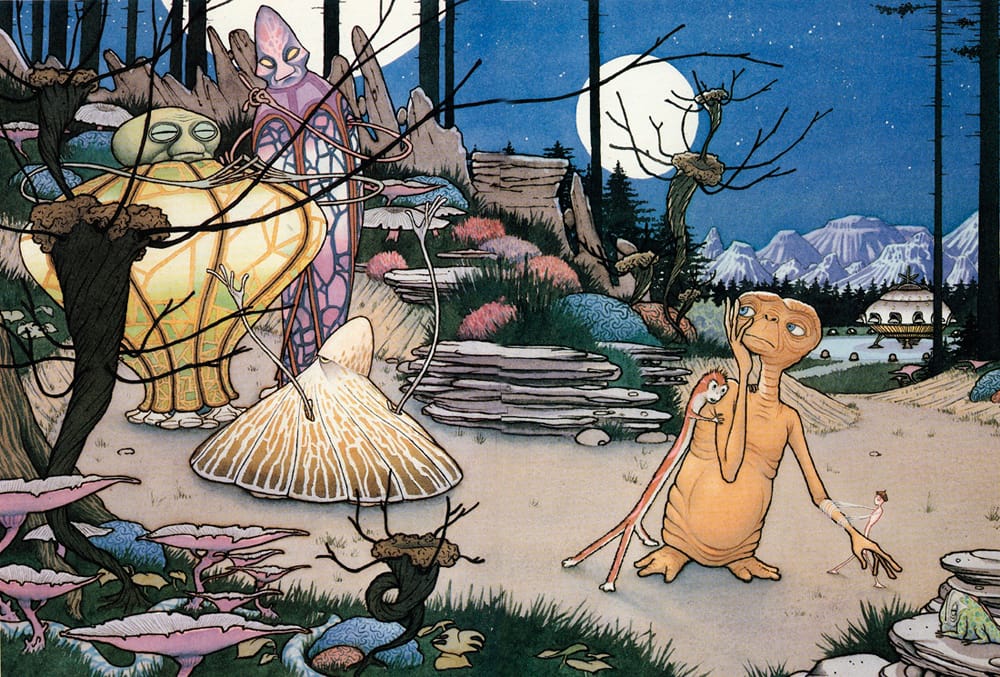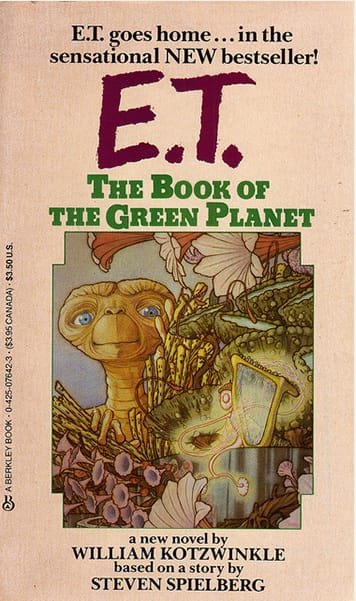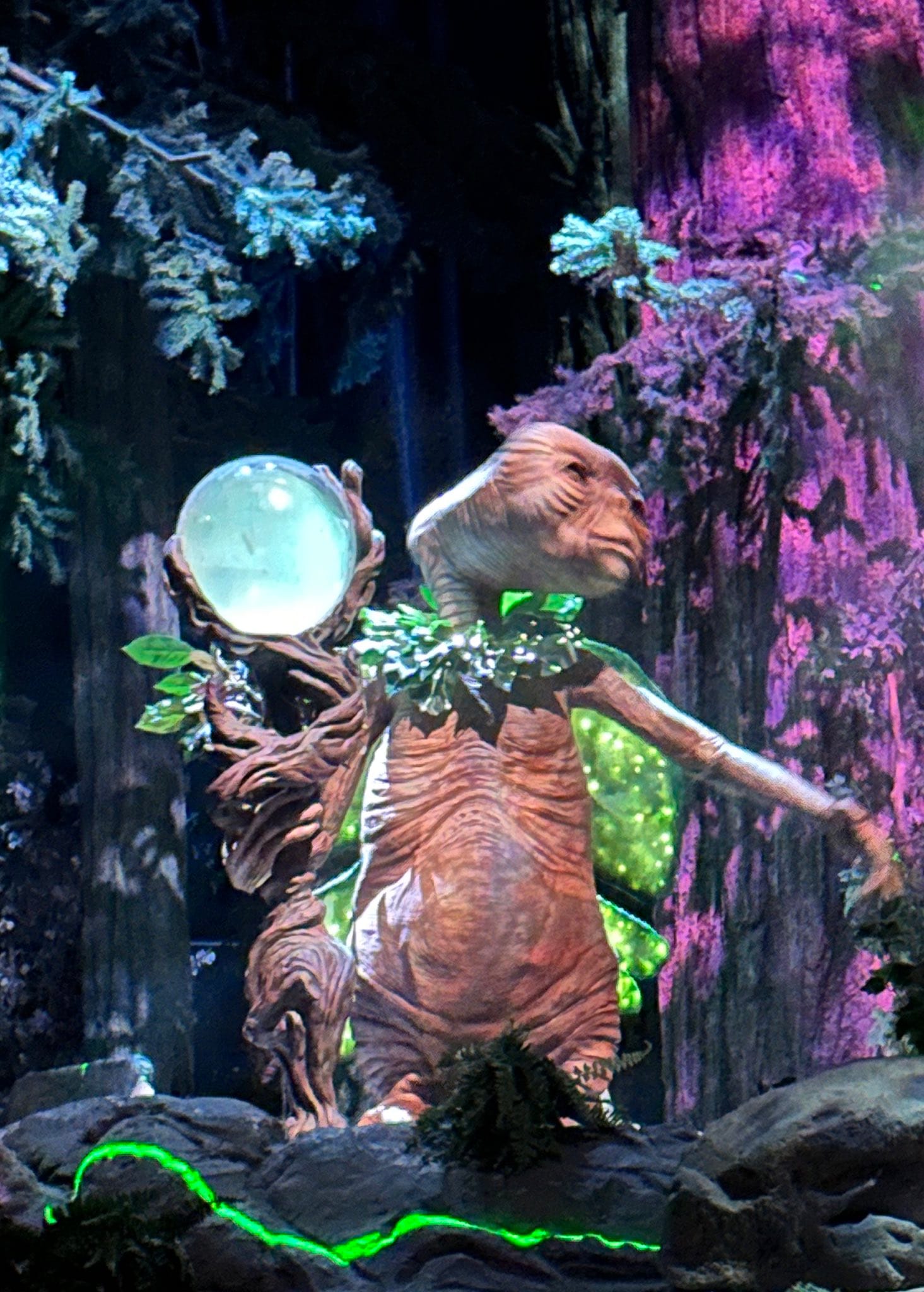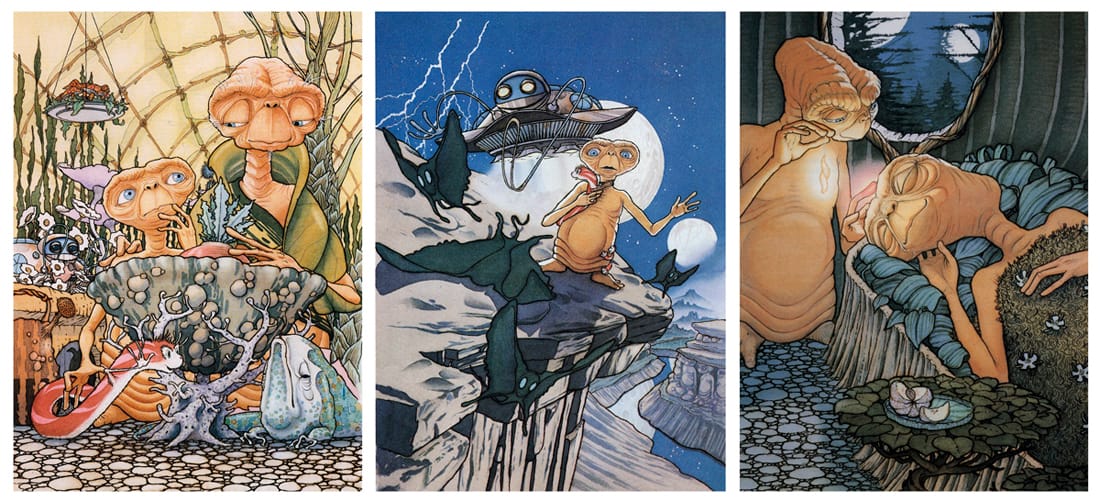Hollywood & Spine Archive: Can You Phone Home Again?
An overview of the novel-only sequel to E.T. THE EXTRA-TERRESTRIAL, originally published in July 2020.

This was a book I read long, long before ever considering Hollywood & Spine as an idea, and as I hope I cover here, it is really, really weird. Proof that it's hard to make a sequel to some stories, a lesson I wish everyone - not just "in" Hollywood, but people who go to movies - understood. (originally published 7/20/2020)

E.T.: The Book of The Green Planet by William Kotzwinkle (based on a story by Steven Spielberg) (Berkeley, 1985)
The pitch: A prose-only sequel to one of the most popular movies of all time, showing what happened after 1982's most famous lost alien teamed up with a lonely 10-year-old boy to return to his home planet.
The author: William Kotzwinkle had already adapted E.T. The Extra-Terrestrial for its bestselling novelization (LINK). He also turned Superman III into a book 1983, but his bibliography is almost entirely original adult and young-adult fiction.
The lowdown: One of the things that makes E.T. so lovable - a snob might say "pure" - is that, unlike nearly every other world-dominating blockbuster film (save for maybe Titanic and a few Pixar movies), there was never a sequel. Director Steven Spielberg and writer Melissa Mathison did consider it, penning a 10-page treatment a month after the film was released. E.T. II: Nocturnal Fears recalled the tone of Night Skies, an unrealized John Sayles sci-fi/horror script that gradually morphed into the basic concept of E.T.; Nocturnal Fears was wisely abandoned, in no small part because it's quite bad.
A year later, Spielberg called up William Kotzwinkle, the author of E.T.'s novelization, to flesh out a follow-up idea that would only live on the page. Kotzwinkle had done a compelling job illustrating E.T's internal monologue in his book, and was the ideal candidate to follow the alien botanist to his galaxy of origin. Strangely, things don't turn out so great for our long-necked pal: in the novelization, we learned that "peeking in windows" was looked down on by the species - but the sequel makes it a full-on crime, worthy of demotion to the most basic of botanical tasks. With the help of some wacky pals, E.T. ends up trying to escape the home he so desperately yearned for in the film and reconnect with his closest friend on Earth. Meanwhile, a now-teenage Elliott (three million light years is a long time) is coping with his first major romantic feelings, his memories of E.T. fading fast the way childhood does.

Kotzwinkle's E.T. adaptation was an entertaining if vaguely unfamiliar trip through familiar territory, rife with characters, scenes and subplots that aren't in the movie - and The Book of The Green Planet keeps that strange balance going. Some writers would attempt to reconcile their prose with the realized celluloid vision when penning a sequel; Craig Shaw Gardner did it for his Back to the Future sequel novelizations, and even fantasy writer Gary K. Wolf did it when commissioned by Disney to write a novel that served as a sequel to his book Who Censored Roger Rabbit? and its film adaptation, Who Framed Roger Rabbit.
Unsurprisingly, Kotzwinkle has no such interest in making The Book of The Green Planet feel more like the E.T. you remember. Other than the substitution of Reese's Pieces for M&Ms, the Kotzwinkle touches are all here: verbose, almost philosophical space heroes; aloof villains; the pain that comes from being misunderstood by your peers (no different on an alien planet, it seems); and yards and yards of florid prose. What was a sometimes food in the original book - turning Earth concepts into malapropisms, like E.T.'s love of "rocks and rolling" music - is fully unchecked the second time around. E.T. describes earthly ideas to his friends with silly self-assurance, some of which we never saw him actually experience in the film. (There were no deleted scenes in the film suggesting the royalty of a Burger King, nor the presence of a wise, round closet dweller named the Baa Sket Baa.)
If you found these tendencies a bother in the original E.T. novel, you may not like them here, either, on top of some other mild annoyances. As a plot device, I rarely enjoy a hero's journey being followed up with them getting knocked back to the start of the game board; doing that in The Book of The Green Planet is particularly weird, because the story then centers on E.T. trying to leave the "home" he was so set on reaching when we last left him. But you have to admit there's a strange, almost forbidden attraction to the idea of an E.T. sequel. I'm not sure its pull is as forceful - this book didn't seem to match the sales figures of its predecessor, even as its street date coincided with a re-release of the original film - but we've always asked ourselves if you can go home again at the box office. Kotzwinkle simply took a different approach here.
The devil in the details: Here, in this book, is where Kotzwinkle unleashed all the sci-fi fantasy details of The Green Planet that would've been too superfluous in the original novelization. It's known by many names under various galactic tongues (one of them, Brodo Asogi, was briefly canonized in pre-Disney Star Wars lore); it's packed with bizarre flora and fauna (beings live in hardened gourds and navigate dozens of living plant creatures, like the mobile Jumpum trees or the self-absorbed breakfast ingredient Antum Tadana) and a weird mix of organic technology, from spooky, secretive capital cities to the multi-fingered Micro Techs that serve as a heightened worker class on the planet.

Kotzwinkle wastes no time in piling on a cast of unusual characters. We meet E.T.'s Parent (Spielberg opined in pre-production of the film that E.T. was plant-based, but this book takes that a touch further); his pet Flopglopple, a loyal, flexible ferret-like being; a trio of celestial outlaws whom E.T. briefly recruits to realize his trip back to Earth; an unnamed, philosophical robot pilot that confusingly shows up more than halfway through the story; and the regal Botanicus, the most intelligent plant doctor of E.T.'s species. If any of this sound vaguely familiar, it's not an accident: Botanicus, along with plant beings like the Tickli Moot-Moot, Orbidon the Cloud Bearer, and Magdol the Sulking Beauty, all appear in E.T. Adventure, the Universal Studios Florida theme park ride based on the film.
Knowing that E.T. got more narrative attention than his human pals in the initial novelization, it's little surprise that our returning human characters again feel like they're getting the short end of the story. Aside from Elliott and Mary, both of whom are pursuing new relationships, none of the other Earth characters (including that foolish nerd Lance, featured only in the original novelization and reappearing in one scene toward the end of the tale) have much to do. Throughout the book, E.T. futilely attempts to send his consciousness (represented as a floating, miniature doppelganger) back to connect with Elliott. There are only a few moments when it's explicitly noticed by anyone, including a bittersweet moment at the book's climax, but The Dissolve summarized this through line brilliantly:
Even when E.T.'s replicant swoops in and improves his host-family's lives...none of them know E.T. is responsible. They just have that familiar feeling of a healing presence nearby, interlaced with a sense of loss. That's the mood Kotzwinkle set so well with E.T. The Extra-Terrestrial in His Adventures on Earth: lightness and whimsy, balanced with a hefty dollop of the forlorn.
In some way, you could interpret this as Kotzwinkle using his sequel to the most popular film at the time to illustrate the folly of the idea. Another adventure with E.T. and Elliott could never match the one-in-a-billion beauty of their first star date, and the author, naturally, stops short of the reunion in the end - a willingness to shade in the concepts that made his approach to E.T. so fascinating, without daring to take the story away from the minds (both creators and fans) that shared it so generously in the first place.

The art: Kotzwinkle adapted both his E.T. books for young readers, and the storybook versions of The Book of The Green Planet feature some original artwork by illustrator David Wiesner that are really worth a look. Check out his work and his thoughts on the project here.
The bottom line: Those that are truly E.T.-curious, or those rightly avoiding a trip to Universal Studios in the middle of a health pandemic, will want to seek this story out - even if it may not be as worth phoning home about the second time around.
